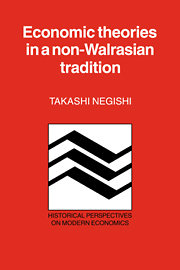Book contents
- Frontmatter
- Contents
- Preface
- 1 Anti-neoclassical or non-Walrasian economic theories
- Part I Increasing returns and diminishing cost
- 2 Adam Smith and increasing returns in a competitive situation
- 3 A reconstruction of Smith's doctrine on the natural order of investment
- 4 The possibility of a falling rate of profit under diminishing cost
- 5 Rehabilitation of Marshall's life-cycle theory to explain diminishing cost
- Part II Wages and profit
- Part III International trade and investment
- Part IV Markets and money
- Notes
- References
- Author index
- Subject index
2 - Adam Smith and increasing returns in a competitive situation
from Part I - Increasing returns and diminishing cost
Published online by Cambridge University Press: 21 September 2009
- Frontmatter
- Contents
- Preface
- 1 Anti-neoclassical or non-Walrasian economic theories
- Part I Increasing returns and diminishing cost
- 2 Adam Smith and increasing returns in a competitive situation
- 3 A reconstruction of Smith's doctrine on the natural order of investment
- 4 The possibility of a falling rate of profit under diminishing cost
- 5 Rehabilitation of Marshall's life-cycle theory to explain diminishing cost
- Part II Wages and profit
- Part III International trade and investment
- Part IV Markets and money
- Notes
- References
- Author index
- Subject index
Summary
A great classic often has many different aspects that permit many different and mutually inconsistent interpretations by later scholars. The wealth of nations of Adam Smith is a good example of such a classic. Karl Marx, for example, highly valued the fact that Smith made a great advance beyond the Physiocrats in the analysis of the nature and origin of surplus values on the basis of the determination of the exchange value of commodities by the quantity of labor expended on them, though he at the same time criticized that Smith's conception of natural price as the sum of wages, profit, and rent falls into a vicious circle (Marx 1963, pp. 70, 83, 93–94). Schumpeter, on the other hand, argued that the rudimentary equilibrium theory in Chapter 7, Book I of The wealth of nations based on the concept of natural price is by far the best piece of economic theory turned out by Adam Smith and it in fact points toward Say and, through Say's work, to Walras (Schumpeter 1954, p. 189).
The division of labor that improves labor productivity is the key characteristic and driving force in The wealth of nations.
- Type
- Chapter
- Information
- Economic Theories in a Non-Walrasian Tradition , pp. 11 - 22Publisher: Cambridge University PressPrint publication year: 1985

